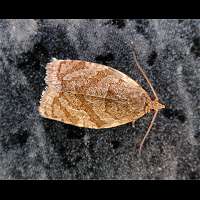Smaller Tea Tortrix (Adoxophyes orana)
The Smaller Tea Tortrix is also known as the Summer Fruit Tortrix Moth and is one of the most devastating pests in apples and pears. The upperwings are light ochreous brown with two darker patterns of a widening strip. Head, thorax and legs whitish brown. The hindwings are light grey. The females differ a bit from the males: they are bigger, the patterns on the front wings are darker and the hind wings are brownish grey. The males will reach a wingspan of 17 to 19 mm, the females up to 22 mm.
The Summer Fruit Tortrix Moth has two generations a year. The eggs for the first generation are deposited in May and June. The eggs are laid in groups of 20 to 100 in a circular form. They are transparent yellow. The larval development inside can be seen as a black dot growing bigger (it is the head of the caterpillar). The larva that hatches will eat leaves (often spun together) or the developing fruit and, if still available, even fruit blossoms. It will reach a length of some 18 to 22 mm and is olive green with a brown head and yellow dots on the flanks. It is highly active and fully grown in just three weeks time. Pupation takes place inside a cocoon in a folded leaf, or two leaves spun together. Out of the dark brown pupa, which is some 11 mm long, comes the second generation. It flies in August and September. Their larvae go into hibernation. They seek shelter in a forked branch, a crack in the bark or a folded leaf, make a cocoon there and wait for spring to come to complete their development. The caterpillars are to be found primarily on apples, but will also attack pears, peaches, cherries or plums. So to sum up: this species is on the wing from May to September, but often with July showing the lowest numbers.
This is one of the most dreaded pests in apples and pears. The larvae will not just stick to the leaves, but will do some damage to the fruit as well. This makes the fruit vulnerable to diseases, especially fungi invasions. Pesticides are reported not to work very well, as the animals have developed some resistance. Mechanical removement of caterpillars and larvae is complicated. The moths can be lured by pheromones, but the method hasn't proved very succesful. Nowadays a virus is used is to get control of this species. The Smaller Tea Tortrix flies from dusk to midnight. It comes to light, but in relatively small numbers. It is a common species all over Europe, including all of the British Isles, the Near and Middle East, Korea, Japan and Northern America.
In the USA better known as the Summer Fruit Tortrix Moth
The Smaller Tea Tortrix is also known as the Summer Fruit Tortrix Moth and is one of the most devastating pests in apples and pears. The upperwings are light ochreous brown with two darker patterns of a widening strip. Head, thorax and legs whitish brown. The hindwings are light grey. The females differ a bit from the males: they are bigger, the patterns on the front wings are darker and the hind wings are brownish grey. The males will reach a wingspan of 17 to 19 mm, the females up to 22 mm.
The Summer Fruit Tortrix Moth has two generations a year. The eggs for the first generation are deposited in May and June. The eggs are laid in groups of 20 to 100 in a circular form. They are transparent yellow. The larval development inside can be seen as a black dot growing bigger (it is the head of the caterpillar). The larva that hatches will eat leaves (often spun together) or the developing fruit and, if still available, even fruit blossoms. It will reach a length of some 18 to 22 mm and is olive green with a brown head and yellow dots on the flanks. It is highly active and fully grown in just three weeks time. Pupation takes place inside a cocoon in a folded leaf, or two leaves spun together. Out of the dark brown pupa, which is some 11 mm long, comes the second generation. It flies in August and September. Their larvae go into hibernation. They seek shelter in a forked branch, a crack in the bark or a folded leaf, make a cocoon there and wait for spring to come to complete their development. The caterpillars are to be found primarily on apples, but will also attack pears, peaches, cherries or plums. So to sum up: this species is on the wing from May to September, but often with July showing the lowest numbers.
This is one of the most dreaded pests in apples and pears. The larvae will not just stick to the leaves, but will do some damage to the fruit as well. This makes the fruit vulnerable to diseases, especially fungi invasions. Pesticides are reported not to work very well, as the animals have developed some resistance. Mechanical removement of caterpillars and larvae is complicated. The moths can be lured by pheromones, but the method hasn't proved very succesful. Nowadays a virus is used is to get control of this species. The Smaller Tea Tortrix flies from dusk to midnight. It comes to light, but in relatively small numbers. It is a common species all over Europe, including all of the British Isles, the Near and Middle East, Korea, Japan and Northern America.
In the USA better known as the Summer Fruit Tortrix Moth





